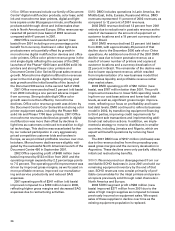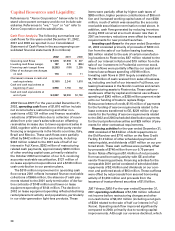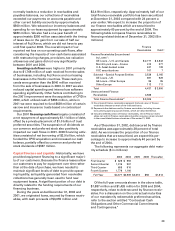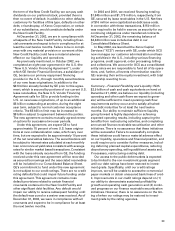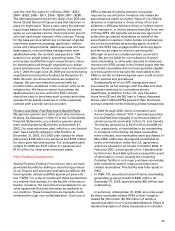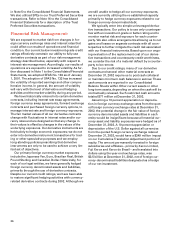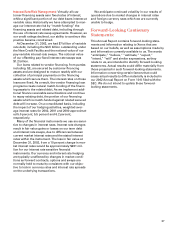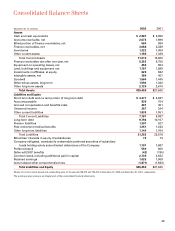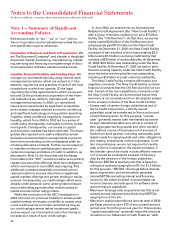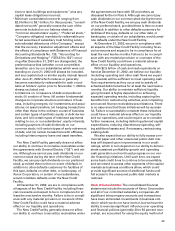Xerox 2002 Annual Report Download - page 38
Download and view the complete annual report
Please find page 38 of the 2002 Xerox annual report below. You can navigate through the pages in the report by either clicking on the pages listed below, or by using the keyword search tool below to find specific information within the annual report.
36
in Note 5 to the Consolidated Financial Statements.
We also utilized SPEs in our Trust Preferred Securities
transactions. Refer to Note 16 to the Consolidated
Financial Statements for a description of the Trust
Preferred Securities transactions.
Financial Risk Management:
We are exposed to market risk from changes in for-
eign currency exchange rates and interest rates that
could affect our results of operations and financial
condition. Our current below investment-grade credit
ratings effectively constrain our ability to fully use
derivative contracts as part of our risk management
strategy described below, especially with respect to
interest rate management. Accordingly, our results of
operations are exposed to increased volatility. As fur-
ther discussed in Note 1 to the Consolidated Financial
Statements, we adopted SFAS No. 133 as of January
1, 2001. The adoption of SFAS No. 133 has increased
the volatility of reported earnings and other compre-
hensive income. In general, the amount of volatility
will vary with the level of derivative and hedging
activities and the market volatility during any period.
We have historically entered into certain derivative
contracts, including interest rate swap agreements,
foreign currency swap agreements, forward exchange
contracts and purchased foreign currency options, to
manage interest rate and foreign currency exposures.
The fair market values of all our derivative contracts
change with fluctuations in interest rates and/or cur-
rency rates and are designed so that any change in
their values is offset by changes in the values of the
underlying exposures. Our derivative instruments are
held solely to hedge economic exposures; we do not
enter into derivative instrument transactions for trad-
ing or other speculative purposes and we employ
long-standing policies prescribing that derivative
instruments are only to be used to achieve a very lim-
ited set of objectives.
Our primary foreign currency market exposures
include the Japanese Yen, Euro, Brazilian Real, British
Pound Sterling and Canadian Dollar. Historically, for
each of our legal entities, we have generally hedged
foreign currency denominated assets and liabilities,
primarily through the use of derivative contracts.
Despite our current credit ratings, we have been able
to restore significant hedging activities with currency-
related derivative contracts during 2002. Although we
are still unable to hedge all our currency exposures,
we are currently utilizing the re-established capacity
primarily to hedge currency exposures related to our
foreign-currency denominated debt.
We typically enter into simple unleveraged deriva-
tive transactions. Our policy is to use only counterpar-
ties with an investment-grade or better rating and to
monitor market risk and exposure for each counter-
party. We also utilize arrangements allowing us to net
gains and losses on separate contracts with all coun-
terparties to further mitigate the credit risk associated
with our financial instruments. Based upon our ongo-
ing evaluation of the replacement cost of our deriva-
tive transactions and counterparty credit-worthiness,
we consider the risk of a material default by a counter-
party to be remote.
Due to our credit ratings, many of our derivative
contracts and several other material contracts at
December 31, 2002 require us to post cash collateral
or maintain minimum cash balances in escrow. These
cash amounts are reported in our Consolidated
Balance Sheets within Other current assets or other
long-term assets, depending on when the cash will be
contractually released. Such restricted cash amounts
totaled $77 million at December 31, 2002.
Assuming a 10 percent appreciation or deprecia-
tion in foreign currency exchange rates from the quot-
ed foreign currency exchange rates at December 31,
2002, the potential change in the fair value of foreign
currency-denominated assets and liabilities in each
entity would be insignificant because all material cur-
rency asset and liability exposures were hedged as of
December 31, 2002. A 10 percent appreciation or
depreciation of the U.S. Dollar against all currencies
from the quoted foreign currency exchange rates at
December 31, 2002, would have a $349 million impact
on our Cumulative Translation Adjustment portion of
equity. The amount permanently invested in foreign
subsidiaries and affiliates – primarily Xerox Limited,
Fuji Xerox and Xerox do Brasil – and translated into
dollars using the year-end exchange rates, was
$3.5 billion at December 31, 2002, net of foreign cur-
rency-denominated liabilities designated as a hedge
of our net investment.


